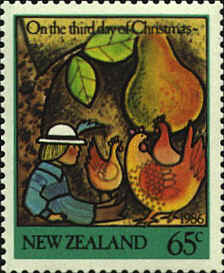|
The earliest printed
version of "The Twelve Days of Christmas" is in a children's book,
Mirth without Mischief, published in 1780. The song, however, is
apparently much older than that, and was originally French rather than
English. For example, the partridge was not introduced into England
from France until the late 1770's.
Some believe that the song is a sort of catechism or
teaching tool for elements of the Catholic faith, but that idea has
been challenged on several grounds, not least the fact that there is
not evidence to demonstrate such a use. The "twelve days" are the days
between Christmas and Epiphany, and refer to the custom of giving
gifts on those days.
For whatever reason the song exists in two versions.
The two versions have the last four lines differing in order. One has
nine drummers drumming, ten pipers piping, eleven ladies dancing,
and twelve lords a-leaping, the other, nine ladies dancing, ten
lords-a-leaping, eleven pipers piping, and twelve drummers drumming.
A further variation is "nine ladies waiting." The "calling
birds" of day four shown on stamps from Christmas Island, and The
Gambia are actually "colly birds" as on the souvenir sheet from
Guernsey.
Several counties have issued stamps for Christmas
based on the song. Apart from the United States the countries are all
from the British commonwealth.
Both the United States and New Zealand issued
stamps based on the first verse, "my true love gave to me, a partridge
in a pear tree."


New Zealand
also issued a set of three stamp based on the first three verses of
the song, and Ireland issued a single stamp based on the same three
verses.

>



Great
Britain issued a set of 6 stamps with two verses on each stamp except
for the first stamp which has only one and the third stamp which has
three..







 |
